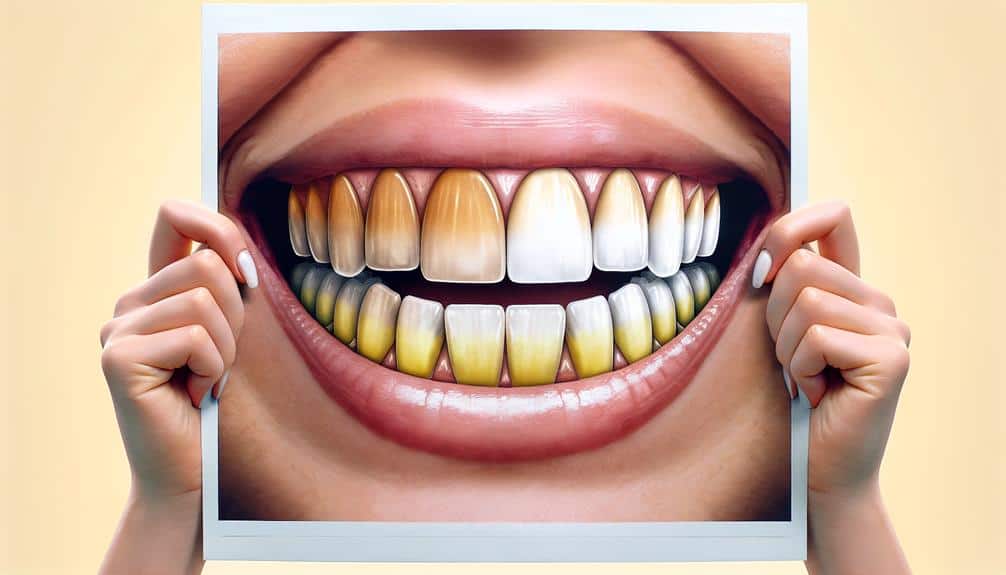Whitening strips provide gradual whitening effects by systematically breaking down stains with active ingredients like hydrogen peroxide or carbamide peroxide. These components target discoloration molecules within your enamel, resulting in a noticeably brighter smile over time. If you'd like to understand more about how whitening strips achieve this gradual whitening process, further details about their mechanism and interaction with tooth enamel are available in the research findings.
Key Points
- Whitening strips break down stains slowly by penetrating enamel.
- Active ingredients target discolored molecules for gradual whitening.
- Consistent use ensures steady improvement in teeth whiteness.
- Slow process prevents enamel damage and sensitivity issues.
- Patience and adherence to instructions lead to a brighter smile.
Mechanism of Whitening Strips
To grasp how whitening strips operate, the active component in the strips, usually hydrogen peroxide or carbamide peroxide, permeates the enamel to disintegrate stains within the teeth. The chemical makeup of these components enables them to interact with the molecules causing discoloration on the tooth surface. Hydrogen peroxide, for example, functions as a bleaching agent that targets the chromophores responsible for the yellowish appearance of teeth. Carbamide peroxide, conversely, decomposes into hydrogen peroxide and urea, enhancing the whitening process.
When it comes to the application technique, it's essential to follow the instructions provided with the whitening strips. Proper application ensures that the active components are evenly spread across the teeth for consistent whitening outcomes. Applying the strips for the recommended duration and avoiding overuse is vital to prevent potential damage to the enamel or sensitivity issues. By comprehending the chemical composition and employing the correct application method, you can maximize the effectiveness of whitening strips while upholding oral health.
Interaction With Tooth Enamel
How do whitening strips interact with the enamel of your teeth to achieve whitening effects?
Whitening strips contain hydrogen peroxide or carbamide peroxide as the active ingredient. When these chemicals come into contact with the teeth, they penetrate the enamel and break down the stains present on the surface. The peroxide compounds in the strips act as oxidizing agents, which means they break apart the chemical bonds of the staining molecules, helping to lighten the discoloration.
During the whitening process, it's important to take into account enamel protection.
While whitening strips are generally safe when used as directed, frequent or prolonged use can lead to enamel damage. Enamel is the outermost layer of the tooth and protects it from daily wear and tear. To safeguard your enamel, it's recommended to follow the instructions provided with the whitening strips carefully. Additionally, consulting with a dentist before starting a whitening treatment can help make sure that your enamel remains protected throughout the process.
Duration of Whitening Treatment
When considering the duration of your whitening treatment with whitening strips, it's important to understand the ideal timeframe for achieving desired results while also prioritizing the health of your enamel. Whitening strips work gradually, requiring consistency over a specific period to achieve the best outcomes.
- Treatment Timeline: The duration of whitening treatment varies based on the product and the level of discoloration.
- Consistent Usage: Using whitening strips daily for the recommended time frame is essential for effective results.
- Patience is Key: Results may not be immediate, so patience and persistence are essential during the whitening process.
- Enamel Health: Prioritize the health of your enamel by following the recommended treatment duration to avoid sensitivity issues.
- Long-Term Results: Maintaining good oral hygiene practices post-treatment can help prolong the whitening effects.
Gradual Breaking Down of Stains
As whitening strips are used consistently over the recommended timeframe, they work by gradually breaking down stains on your teeth to reveal a brighter smile. Stains on teeth are caused by various factors such as pigmented food and beverages, smoking, or poor oral hygiene. These stains can penetrate the enamel, the outer layer of the tooth, causing discoloration that may be hard to remove with regular brushing alone.
Whitening strips contain active ingredients like hydrogen peroxide or carbamide peroxide, which help in breaking down these stains. These ingredients penetrate the enamel and reach the discolored molecules within the tooth. Over time, with regular use, the whitening strips effectively break down these stains, leading to a gradual but noticeable improvement in the whiteness of your teeth.
It is essential to note that while whitening strips are effective in stain removal, they should be used according to the instructions provided to prevent enamel damage. Protection of enamel is vital during the whitening process to maintain the structural integrity of your teeth while achieving a brighter smile.
Sensitivity and Whitening Speed
To assess the impact of sensitivity on the speed of whitening, consider the varying factors that can influence the effectiveness of whitening strips. Sensitivity management plays an important role in determining the whitening progress you can achieve. Here are some key points to understand how sensitivity and whitening speed are interconnected:
- Sensitivity Management: Properly managing tooth sensitivity can help you continue using whitening strips consistently, ensuring steady progress.
- Whitening Progress: Sensitivity can sometimes slow down the whitening process, as individuals may need to take breaks between treatments to alleviate discomfort.
- Speed Variation: Individuals may experience variations in the speed of whitening due to differences in enamel thickness and overall oral health.
- Enamel Protection: Ensuring the protection of the enamel is essential; sensitivity can indicate enamel damage, highlighting the importance of choosing whitening products that prioritize enamel health.
- Consultation: If sensitivity persists or worsens, consulting with a dental professional is essential to address any underlying issues.
Frequently Asked Questions
Can Whitening Strips Be Used on Dental Restorations Like Crowns or Veneers?
You might wonder if whitening strips play nice with dental restorations like crowns or veneers. Well, these strips work best on natural teeth, not on artificial surfaces. They're like artists who prefer to work on their own canvas!
Are There Any Long-Term Effects on Tooth Enamel From Using Whitening Strips?
To maintain enamel health and minimize sensitivity, using whitening strips gradually for their whitening process can be effective. Long-term effects on tooth enamel may occur if strips are overused, emphasizing the importance of following instructions.
Can Whitening Strips Remove Deep-Set Stains From Smoking or Coffee?
Explore thoroughly into the domain of whitening strips for addressing those persistent deep-seated stains. While strips are effective, consider alternatives like professional treatments or at-home remedies for more immediate results on smoking or coffee discoloration.
How Often Should Whitening Strips Be Used for Maintenance After the Initial Treatment?
For the best upkeep after your first treatment, utilize whitening strips as advised by your dentist. Regular use guarantees long-lasting results. Follow directions for frequency to sustain desired whiteness and prolong effectiveness.
Are There Any Potential Side Effects of Using Whitening Strips Over a Long Period of Time?
Over time, whitening strips may lead to tooth sensitivity, enamel erosion, gum irritation, and discoloration. It's important to monitor usage and consult a dentist for guidance on maintaining oral health while achieving desired results.



